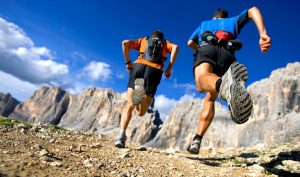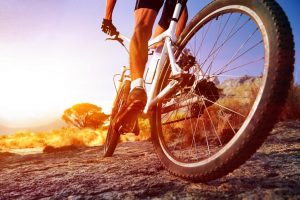TRAIL SHOES

Trail shoes are a definite necessity for running in Namibia- to give you good grip and stability and cushioning for your feet over
the long distances. Some of you will already have some and have a brand/model preference- but it is well worth trying some well in advance of the trip and wearing them in. Phill and Gregg have advised that the hard surfaces in parts of the Namib desert mean you won’t need intense grip for mud etc- but do need to make sure that they are comfortable over long distances.
A few notes on trail shoes from Runners World magazine:
- Traction. The soles of road shoes are meant to grip roads, meaning they’re not very effective on dirt, mud and rock. Trail shoes utilize various traction—like large lugs, multi-directional lugs with teeth strategically placed to maximize grip, and sticky rubber compounds to give you more control on a variety of trail surfaces.
- Protection. Unlike road shoes, trail shoes often feature tighter-weaved mesh uppers to protect your socks and feet from trail debris, as sand, silt and dirt are blocked by the tight weave. Also, those beefy, rubber caps you often see on the toes of trail shoes serve an important purpose. They’re called “toe bumpers,” and they protect your toes from pain and bruises, should you kick a rock or root. And finally, most trail running shoes have some sort of flexible (some are more flexible than others), hard plastic plate within the midsole that’s there to block sharp jabs from rocks, roots, sticks and such. The plate saves the underside of your feet from surprising pain.
- Support/Stability. Some road shoes—the ones built for overpronators—have stability built into the midsole to straighten our a runner’s footstrike. But trail shoes provide stability to all runners, neutral and overpronators alike…and everyone in between. This is a different kind of stability (though an increasing number of trail shoes are integrating traditional medial posts into their shoes). Trail shoe stability comes from more supportive materials on the upper that really aim to strap your foot down and keep it from slip-sliding around too much. That, joined with what’s often a more secure fit in the heel that fans out to a wider toe box, provides stability within the shoe. Externally, trail shoes often feature a wider platform.
A few examples of recommended brands are Salomon, Adidas (Raven), New Balance (Leadville, Fresh Foam Gobi Trail, Fresh Foam Hierro), Brooks (Adrenaline, Cascadia), Asics (Gel Fuji Lyte), Saucony (Ride 9GXX)- have a look and try on a few pairs in your local running shop to work out what fits your feet best.

BIKE SHOES
 For this trip, you will need bike shoes with SPDs. Recommended are the new softer trail shoe type of SPD mountain bike style shoe- these are far more flexible and you can walk around easier, as well as porter easier over rocks\sand when you dismount.
For this trip, you will need bike shoes with SPDs. Recommended are the new softer trail shoe type of SPD mountain bike style shoe- these are far more flexible and you can walk around easier, as well as porter easier over rocks\sand when you dismount.

CLOTHING ADVICE
When running, cycling and climbing through the desert you will need to make sure you’re keeping cool and protecting your skin from the sun. Light, breathable, sweat-wicking material is best, rather than cotton which gets heavy with sweat. For the evenings, make sure to bring a warm layer when the desert temperature drops. No dresses or evening wear are necessary for the trip week- you’ll feel glamorous enough after a shower!
- Make sure to bring light long-sleeved shirts to cover your arms
- Wear a hat with a back flap to keep as much sun off your head and neck as possible
- For your bike shorts- the thicker the padding, the better! Don’t skimp on quality here, as seams and chaffing can make long-distance cycling very uncomfortable. Well worth investing in a quality pair.
- Please make sure to bring your own helmet
Of course, wearing high-factor suncream on all exposed skin is a must.
CARRYING WATER

When running you will stop every 7km for a water break, and when on bikes the stops will be approx. every 15km (though you’ll have 2 water bottles on your bike). When climbing the Brandberg you will be provided with adequate water in your backpack. However, you may wish to carry your own water throughout the day- a bladder system such as a Camelback or a similar brand will be ideal. You shouldn’t need more than a 1.5l capacity before having the chance to refill.